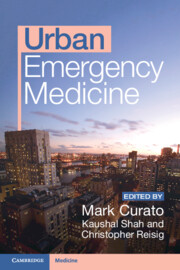Book contents
- Urban Emergency Medicine
- Urban Emergency Medicine
- Copyright page
- Contents
- Contributors
- Preface
- Chapter 1 Caring for the Homeless
- Chapter 2 Disruptive and Dangerous Agitation
- Chapter 3 Penetrating Trauma
- Chapter 4 Substance Use
- Chapter 5 Human Trafficking
- Chapter 6 Travelers from Overseas
- Chapter 7 HIV, AIDS, and Tuberculosis
- Chapter 8 Asthma
- Chapter 9 Physician/Patient Discordance
- Chapter 10 LGBTQIA+ Care
- Chapter 11 Child Maltreatment
- Chapter 12 Care of Vulnerable Elders
- Chapter 13 Civil Unrest: Caring for Police and Protesters
- Chapter 14 Terrorism and Mass Casualty Incidents
- Chapter 15 Overcrowding, Triage, and Care Rationing
- Index
- References
Chapter 4 - Substance Use
Published online by Cambridge University Press: 20 July 2023
- Urban Emergency Medicine
- Urban Emergency Medicine
- Copyright page
- Contents
- Contributors
- Preface
- Chapter 1 Caring for the Homeless
- Chapter 2 Disruptive and Dangerous Agitation
- Chapter 3 Penetrating Trauma
- Chapter 4 Substance Use
- Chapter 5 Human Trafficking
- Chapter 6 Travelers from Overseas
- Chapter 7 HIV, AIDS, and Tuberculosis
- Chapter 8 Asthma
- Chapter 9 Physician/Patient Discordance
- Chapter 10 LGBTQIA+ Care
- Chapter 11 Child Maltreatment
- Chapter 12 Care of Vulnerable Elders
- Chapter 13 Civil Unrest: Caring for Police and Protesters
- Chapter 14 Terrorism and Mass Casualty Incidents
- Chapter 15 Overcrowding, Triage, and Care Rationing
- Index
- References
Summary
It has been estimated that 11% of United States ED patients have substance use disorder. One urban ED estimated that nearly 7% of visits were due to illicit drug use. In a large statewide review of ED visits, alcohol use disorder was more prevalent in rural settings while opioid use disorder was more prevalent in urban settings. Substance use leads to harmful outcomes such as acute injuries, overdose, and medical complications. Forensic laboratory data offers some insight on which drugs are commonly used in US cities. (Ethanol is not included in these reports, but is used ubiquitously and considered to be the most commonly used intoxicating drug.) Opioids, sympathomimetics, cannabinoids, and sedatives classes predominate in all US cities, although there is some regional variation of the specific drugs used among cities. In Baltimore, for example, the top four drugs identified are cocaine, fentanyl, heroin, and tramadol; in Phoenix, the top four are cannabis, fentanyl, heroin, and methamphetamines.
Keywords
- Type
- Chapter
- Information
- Urban Emergency Medicine , pp. 39 - 55Publisher: Cambridge University PressPrint publication year: 2023



